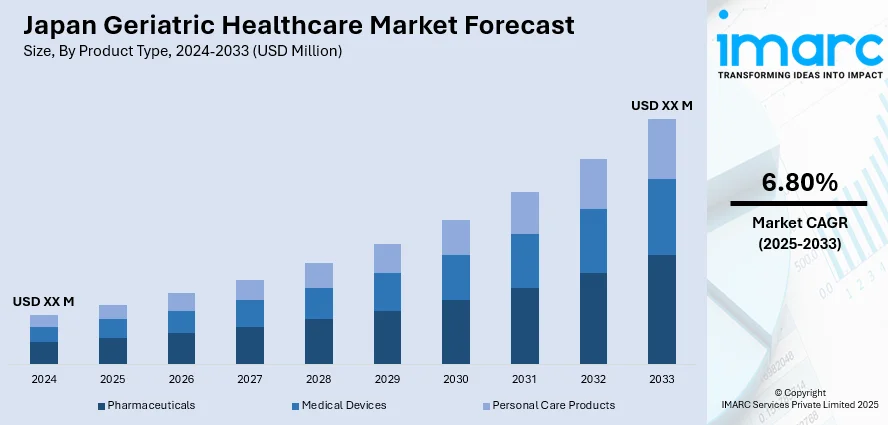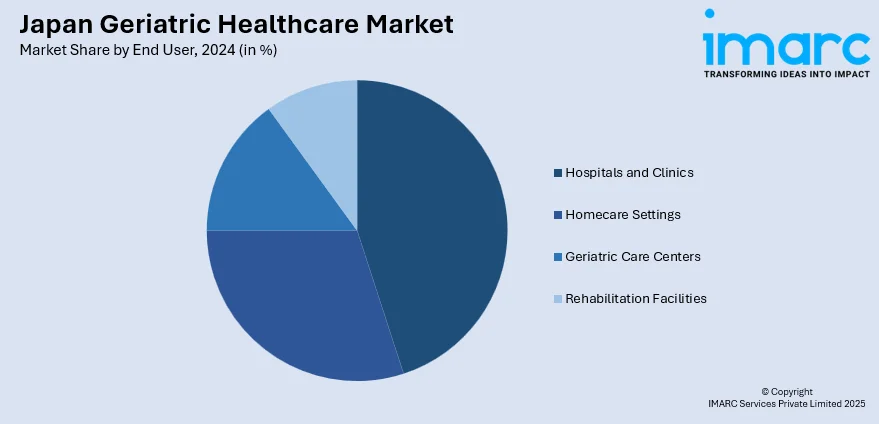
Japan Geriatric Healthcare Market Size, Share, Trends and Forecast by Product Type, Service Type, Disease Indication, End User, and Region, 2025-2033
Japan Geriatric Healthcare Market Overview:
The Japan geriatric healthcare market size is projected to exhibit a growth rate (CAGR) of 6.80% during 2025-2033. The market is fueled by the country's rapidly aging population and improvement in healthcare technology, like telemedicine and remote monitoring systems, which is enabling more effective and convenient care for the elderly. Government policies and efforts to facilitate elderly care, in the form of economic incentives and infrastructure development, along with the innovation in caregiving products and services for the elderly, which is further highlighting the dynamic expansion of the Japan geriatric healthcare market share.
|
Report Attribute
|
Key Statistics
|
|---|---|
|
Base Year
|
2024
|
|
Forecast Years
|
2025-2033
|
|
Historical Years
|
2019-2024
|
| Market Growth Rate 2025-2033 | 6.80% |
Japan Geriatric Healthcare Market Trends:
Integration of High-Tech in Elderly Care
Japan's geriatric healthcare system is increasingly adopting high-tech in their efforts to counter the challenges brought about by its aging population. According to industry reports, when Japan's birth rate touched a record low in 2024, the country's senior population reached a record high of 36.25 million. Hence, new technologies like telemedicine, remote monitoring equipment, and assistive technologies are being integrated into models of care, improving service accessibility, efficiency, and patient outcomes. The technologies enable remote consultations and monitoring, enabling elderly individuals to better manage chronic conditions and live independently. In addition, the creation of AI-based robots and home automation systems is targeted at aiding activities of daily living, lessening the burden on caregivers, and facilitating aging in place. Use of these technologies improves the quality of care and also reflects cultural desires for community and home-based living conditions. With Japan continuing to make advancements in this area, these advances are bound to have a significant impact on the Japan geriatric healthcare market growth.

To get more information of this market, Request Sample
Shift Toward Aging in Place and Community-Based Care
One of the significant trends in Japan's geriatric healthcare sector is the focus on "aging in place," where older people are encouraged to stay in their own homes and communities as long as possible. This strategy is consistent with cultural values that emphasize family and community participation in caregiving. To facilitate this model, home healthcare services have grown, including home adjustment, remote monitoring technologies, and mobile healthcare services. Such services allow the elderly to stay at home and obtain medical care and assistance, decreasing the requirement for institutional care. In addition, care models based on communities are being established to offer all-around care comprising medical, social, and psychological services, adapted to the elderly. Government policies and programs are key to determining this situation through the improvement of healthcare infrastructure and putting regulatory measures in place for ensuring the quality and safety of care services.
Workforce Challenges and Innovative Solutions
The increasing need for care for the elderly in Japan has placed emphasis on major labor challenges, such as a lack of caregivers and an aging healthcare workforce. A falling birth rate and a restrictive immigration policy help to exacerbate the problem. There is thus an effort to come up with creative alternatives to supplement human care. For example, robots equipped with artificial intelligence are being created to help with lifting patients, cooking, and laundry, which would decrease the physical burden on caregivers. Training sessions for caregivers are also being upgraded for skills improvement and increased retention rates. Integration of technology with caregiving not only responds to labor shortages but enhances the quality and efficiency of care delivered to the elderly. Despite challenges, these creative solutions are an active response to making certain Japan's elderly population is properly cared for and supported.
Japan Geriatric Healthcare Market Segmentation:
IMARC Group provides an analysis of the key trends in each segment of the market, along with forecasts at the country and regional levels for 2025-2033. Our report has categorized the market based on product type, service type, disease indication, and end user.
Product Type Insights:
- Pharmaceuticals
- Medical Devices
- Personal Care Products
The report has provided a detailed breakup and analysis of the market based on the product type. This includes pharmaceuticals, medical devices, and personal care products.
Service Type Insights:
- Home Healthcare Services
- Hospital and Clinical Services
- Assisted Living and Nursing Care
- Palliative and Hospice Care
A detailed breakup and analysis of the market based on the service type has also been provided in the report. This includes home healthcare services, hospital and clinical services, assisted living and nursing care, and palliative and hospice care.
Disease Indication Insights:
- Cardiovascular Diseases
- Neurological Disorders
- Diabetes and Endocrine Disorders
- Respiratory Disorders
- Osteoarthritis and Musculoskeletal Disorders
- Cancer
- Others
The report has provided a detailed breakup and analysis of the market based on the disease indication. This includes cardiovascular diseases, neurological disorders, diabetes and endocrine disorders, respiratory disorders, osteoarthritis and musculoskeletal disorders, cancer, and others.
End User Insights:

- Hospitals and Clinics
- Homecare Settings
- Geriatric Care Centers
- Rehabilitation Facilities
A detailed breakup and analysis of the market based on the end user has also been provided in the report. This includes hospitals and clinics, homecare settings, geriatric care centers, rehabilitation facilities.
Regional Insights:
- Kanto Region
- Kansai/Kinki Region
- Central /Chubu Region
- Kyushu-Okinawa Region
- Tohoku Region
- Chugoku Region
- Hokkaido Region
- Shikoku Region
The report has also provided a comprehensive analysis of all the major regional markets, which include Kanto Region, Kansai/Kinki Region, Central /Chubu Region, Kyushu-Okinawa Region, Tohoku Region, Chugoku Region, Hokkaido Region, and Shikoku Region.
Competitive Landscape:
The market research report has also provided a comprehensive analysis of the competitive landscape. Competitive analysis such as market structure, key player positioning, top winning strategies, competitive dashboard, and company evaluation quadrant has been covered in the report. Also, detailed profiles of all major companies have been provided.
Japan Geriatric Healthcare Market News:
- In March 2025, one of the largest insurance companies in Japan, Sompo Holdings, Inc., claimed that it is utilizing artificial intelligence to help address a severe labor shortage that is required to care for the elderly population of the nation.
Japan Geriatric Healthcare Market Report Coverage:
| Report Features | Details |
|---|---|
| Base Year of the Analysis | 2024 |
| Historical Period | 2019-2024 |
| Forecast Period | 2025-2033 |
| Units | Million USD |
| Scope of the Report |
Exploration of Historical Trends and Market Outlook, Industry Catalysts and Challenges, Segment-Wise Historical and Future Market Assessment:
|
| Product Types Covered | Pharmaceuticals, Medical Devices, Personal Care Products |
| Service Types Covered | Home Healthcare Services, Hospital and Clinical Services, Assisted Living and Nursing Care, Palliative and Hospice Care |
| Disease Indications Covered | Cardiovascular Diseases, Neurological Disorders, Diabetes and Endocrine Disorders, Respiratory Disorders, Osteoarthritis and Musculoskeletal Disorders, Cancer, Others |
| End Users Covered | Hospitals and Clinics, Homecare Settings, Geriatric Care Centers, Rehabilitation Facilities |
| Regions Covered | Kanto Region, Kansai/Kinki Region, Central /Chubu Region, Kyushu-Okinawa Region, Tohoku Region, Chugoku Region, Hokkaido Region, Shikoku Region |
| Customization Scope | 10% Free Customization |
| Post-Sale Analyst Support | 10-12 Weeks |
| Delivery Format | PDF and Excel through Email (We can also provide the editable version of the report in PPT/Word format on special request) |
Key Questions Answered in This Report:
- How has the Japan geriatric healthcare market performed so far and how will it perform in the coming years?
- What is the breakup of the Japan geriatric healthcare market on the basis of product type?
- What is the breakup of the Japan geriatric healthcare market on the basis of service type?
- What is the breakup of the Japan geriatric healthcare market on the basis of disease indication?
- What is the breakup of the Japan geriatric healthcare market on the basis of end user?
- What is the breakup of the Japan geriatric healthcare market on the basis of region?
- What are the various stages in the value chain of the Japan geriatric healthcare market?
- What are the key driving factors and challenges in the Japan geriatric healthcare market?
- What is the structure of the Japan geriatric healthcare market and who are the key players?
- What is the degree of competition in the Japan geriatric healthcare market?
Key Benefits for Stakeholders:
- IMARC’s industry report offers a comprehensive quantitative analysis of various market segments, historical and current market trends, market forecasts, and dynamics of the Japan geriatric healthcare market from 2019-2033.
- The research report provides the latest information on the market drivers, challenges, and opportunities in the Japan geriatric healthcare market.
- Porter's five forces analysis assist stakeholders in assessing the impact of new entrants, competitive rivalry, supplier power, buyer power, and the threat of substitution. It helps stakeholders to analyze the level of competition within the Japan geriatric healthcare industry and its attractiveness.
- Competitive landscape allows stakeholders to understand their competitive environment and provides an insight into the current positions of key players in the market.
Need more help?
- Speak to our experienced analysts for insights on the current market scenarios.
- Include additional segments and countries to customize the report as per your requirement.
- Gain an unparalleled competitive advantage in your domain by understanding how to utilize the report and positively impacting your operations and revenue.
- For further assistance, please connect with our analysts.
 Request Customization
Request Customization
 Speak to an Analyst
Speak to an Analyst
 Request Brochure
Request Brochure
 Inquire Before Buying
Inquire Before Buying




.webp)




.webp)












